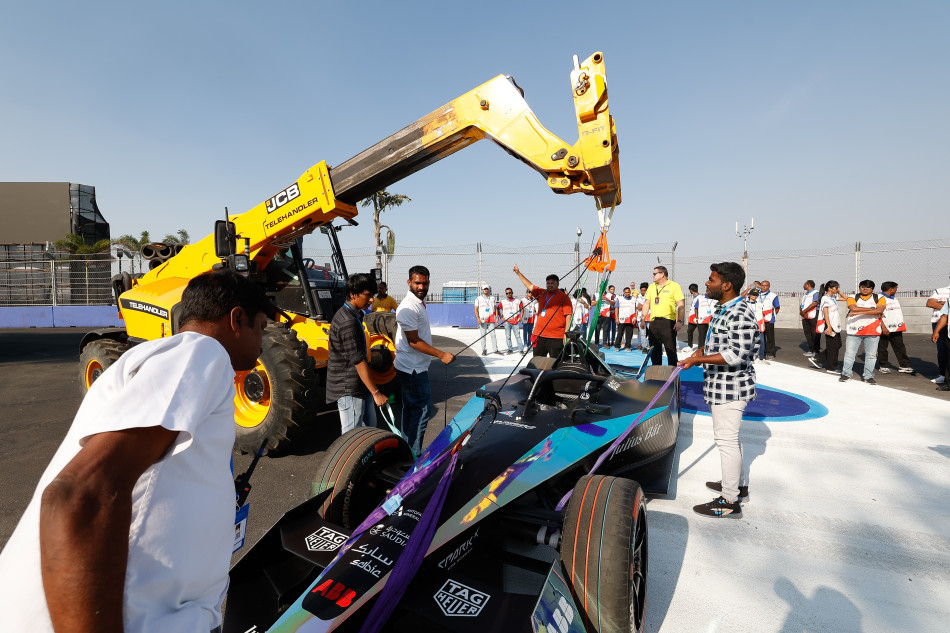COMPREHENSIVE PRE-EVENT TRAINING CONTRIBUTES TO ALL-ROUND SUCCESS OF INAUGURAL HYDERABAD E-PRIX
ABB FIA Formula E World Championship Deputy Race Director commends commitment and enthusiasm of Indian marshals and ASN.

Widely hailed as one of the best races in ABB FIA Formula E World Championship history, the inaugural Hyderabad E-Prix (11 February) was a smooth affair from start to finish – thanks in no small part to a comprehensive suite of pre-event preparations.
As the first completely new circuit visited during Season 9 in the pioneering all-electric series, a special training programme was implemented in the Indian city, to ensure the local ASN and its volunteer marshals were equipped to deal with any eventuality – in so doing, contributing significantly to the safe and seamless running of the race weekend.
Taking place over two-and-a-half days and comprising both theoretical and practical elements, these exercises were overseen by Head of Formula E Event Operations at the FIA, Javier Maffioli and FIA Formula E Deputy Race Director, Marek Hanaczewski. Around 300 local marshals participated, mostly young and the majority with minimal prior motor sport experience. In evidence of their passion and commitment, many travelled as far as three hours from their homes in order to be part of the event.

The training began with an initial briefing and overview of the championship, including a focus on the specificities of the new Gen3 single-seater. This was followed by a recap of duties and responsibilities – for marshals, the local ASN crew, FIA Race Control and the FIA trackside team – and an insight into how all of those roles interact with one another.
A meeting with the ASN crew offered the opportunity to discuss processes with the Clerk of the Course – who liaises between the Race Director and the marshals on-track – while there was also a video presentation with the car recovery unit and a Q&A with the ASN Race Control team.
Once the theory was completed, preparations moved on to the practical phase. A hands-on demo enabled the local volunteers to get to grips with Gen3’s relevant features and status lights, with a session for intervention marshals covering the full recovery procedure from pushing the car to picking it up, carrying it using a telehandler and finally loading it onto a flatbed truck.
A variety of scenarios were simulated to test the reactions of intervention and flag marshals, ranging from stranded or crashed cars to driver injuries and Safety Car or Full Course Yellow interruptions.
Telehandler drivers were additionally educated with regard to potential incidents, moving on the track, hand signal communication between drivers and intervention marshals and relocation following periods of neutralisation.
Radio communication training, meanwhile, was designed to make sure all stakeholders – from FIA Race Direction to the ASN Race Control team, intervention marshals, flag marshals and the medical crew – were using the same vocabulary and could clearly understand each other’s instructions and responses.
“Being a new addition to the calendar, the Hyderabad E-Prix required more preparation work than most other races – both on a logistical and human level,” explained Hanaczewski. “There was huge anticipation and excitement in the build-up to the event, and I think it’s no exaggeration to say it was a resounding success.
“A large part of the credit for that must go to the local ASN and the Indian marshals, who participated actively and enthusiastically in the training we put in place before the race weekend. Our firm intention was that they should benefit equally through the development of their own skills, and this exchange of information and expertise will stand them in good stead for future national events in which they are involved.”
This type of training will be implemented at all new circuits on the Formula E calendar, continuing at the next round in Cape Town on 25 February.


 Facebook
Facebook Twitter
Twitter






